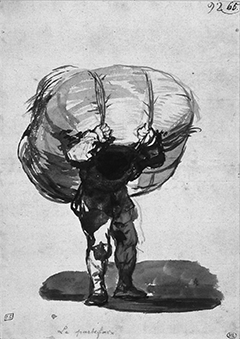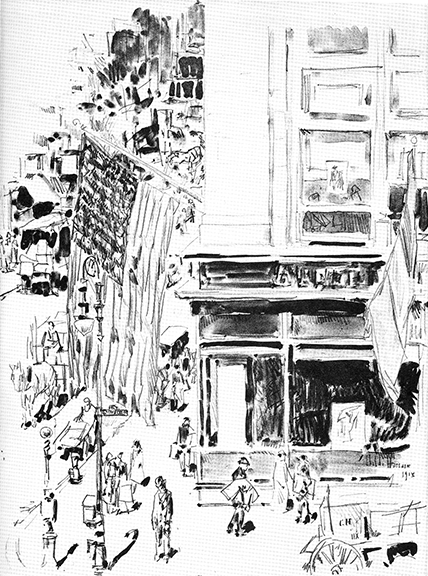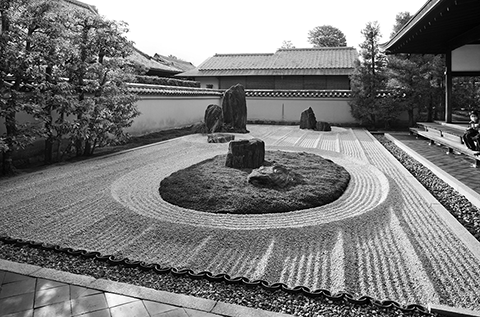Test Information Guide
Field 17: Visual Art
Sample Multiple-Choice Questions
Creating Works of Visual Art
Objective 0001
Understand the elements of art and principles of design and their use in works of
art.
1. Use the reproduction below of Lafayette Street (1918) by Frederick Childe Hassam to answer the question that follows.
drawing of a street with a tall building out in front with a u s flag hanging from the corner of the building and right in front of the flag is a light pole in front of the building there are people in the street behind the building and the street with carts and further back are more buildings caption Hassam, Childe. Lafayette Street. The Metropolitan Museum of Art, Gift of Mrs. Childe Hassam, 1940 (40.30.46). Image copyright The Metropolitan Museum of Art. Used with permission.
The artist creates a sense of depth in this work through the use of:
- gestural lines.
- repetition.
- movement.
- overlapping.
- Answer
- Correct Response: D.
Correct Response: D.
Objective 0002
Understand tools, materials, techniques, methods, processes, and technologies employed
in visual art and design.
2. A tripod is especially helpful when photographing in low light because it allows the photographer to use a:
- longer lens.
- slower shutter speed.
- wider aperture.
- shorter focal length.
- Answer
- Correct Response: B.
Correct Response: B.
Objective 0003
Understand the thinking strategies employed in creating works of art.
3. Which of the following art activities would be most appropriate for promoting the development of creative thinking in five-year-old children?
- displaying an image of an animal by a famous artist, then asking the children to create their own pictures of that animal
- having children collaborate on designing and creating a mural that depicts famous people in history
- providing each child with a page with a simple shape on it and asking them to complete the picture
- asking children to create a storyboard of three panels featuring a favorite character from television, movies, or comic books
- Answer
- Correct Response: C.
Correct Response: C.
Objective 0004
Understand artistic development in children and adolescents.
4. An art teacher displays photographs of masks from a wide variety of world cultures. After students have had the opportunity to view all the masks, the teacher leads a discussion about how the masks were made, the purposes of the masks, and how each mask reflects the culture in which it was created. This is an example of how visual arts education contributes to:
- appreciation of human diversity.
- analytic abilities.
- creative problem solving.
- perceptual awareness.
- Answer
- Correct Response: A.
Correct Response: A.
Visual Art in Context
Objective 0005
Understand the connections among art, history, and culture.
5. In communist states, government-sanctioned art has traditionally been used for which of the following purposes?
- maintaining citizens' connection to folk traditions
- reflecting the diversity of the population
- providing an opportunity for the open exchange of ideas
- promoting a specific political and social ideology
- Answer
- Correct Response: D.
Correct Response: D.
Objective 0006
Understand artworks from Africa, Asia, Central America, Europe, the Middle East,
North America, Oceania, and South America from ancient times through the present.
6. Use the reproduction below of a nineteenth-century engraving of a Polynesian
warrior to answer the question that follows.

In Polynesian culture, tattoos such as those depicted in the engraving of a Polynesian warrior above were bestowed for the purpose of:
- increasing social status.
- warding off evil spirits.
- attracting a mate.
- providing camouflage.
- Answer
- Correct Response: A.
Correct Response: A.
Interpretation, Analysis, and Evaluation of Art
Objective 0007
Understand visual art as a form of communication.
7. Use the reproduction below of Le Portefaix (The Porter) by Francisco Goya to answer the question that follows.

Which of the following themes is expressed by this drawing?
- the oppression of the laboring classes
- the nobility of honest work
- the universality of the human condition
- the rewards of self-denial
- Answer
- Correct Response: A.
Correct Response: A.
Objective 0008
Understand major functions, purposes, theories, and philosophies of art.
8. Use the reproduction below of Stone and Sand Zen Garden (sixteenth century CE) at the Ryogen-in Temple in Kyoto, Japan, to answer the question that follows.
Garden that has a circular patch of grass with a couple large rocks on it is in the center of a large sand pit with a few large stones the sand is raked in perfectly straight lines except around the circular grass patch where it is raked into a circle surrounding the patch of grass.
Which of the following terms best describes the primary purpose of gardens such as the one shown here?
- decorative
- meditative
- recreational
- ceremonial
- Answer
- Correct Response: B.
Correct Response: B.
Objective 0009
Understand the basic principles of art criticism: description, analysis, interpretation,
and evaluation of works of visual art.
9. Which of the following would be the most appropriate question for a viewer to ask before analyzing a work of art from an unfamiliar culture?
- How skillful was the artist who created the work?
- What feelings is the work likely to elicit in a viewer?
- In what aesthetic context was the work created?
- What is the approximate age of the work?
- Answer
- Correct Response: C.
Correct Response: C.
Visual Art and Other Disciplines
Objective 0011
Understand relationships between the visual arts and other disciplines in the curriculum.
10. Which of the following art activities would most promote student comprehension of the concept of ratio in mathematics?
- Draw a human body lying on its back, foreshortening the legs and torso.
- Design an accurate representation of a box of cereal that is three times the size of the actual box.
- Sketch a three-dimensional rendering of an adult's hand and a child's hand.
- Paint a landscape with roadside trees that decrease in size and vanish at a single point.
- Answer
- Correct Response: B.
Correct Response: B.
Acknowledgments
Question 1: Hassam, Childe. Lafayette Street. The Metropolitan Museum of Art, Gift of Mrs. Childe Hassam, 1940 (40.30.46). Image copyright © The Metropolitan Museum of Art. Used with permission.Question 6: Unknown Artist. Distinguished Inhabitant of the Island of Nukuhiwa, Marquesas Islands (Polynesia). Print. Bibliotheque Nationale, Paris, France. Photo Credit: Snark / Art Resource, NY. Used with permission.
Question 7: Goya y Lucientes, Francisco de (1746–1828). Le Portefaix (The Porter). Drawing, brown wash 22 x 48 cm. Louvre, Paris, France. Photo Credit: Réunion des Musées Nationaux / Art Resource, NY. Used with permission.
Question 8: Unknown Artist. Isshidan Stone and Sand Zen Garden. Ryogen-in Temple, Daitoku-ji religious complex, Kyoto, Japan. This garden is designed in the Kare-Sansui (dry landscape) style. The temple was constructed in 1502 by priest Tokei, in the Muromachi period. Daitoku-ji Temple, Kyoto, Kyoto Prefecture, Japan. Photo Credit: Vanni / Art Resource, NY.


